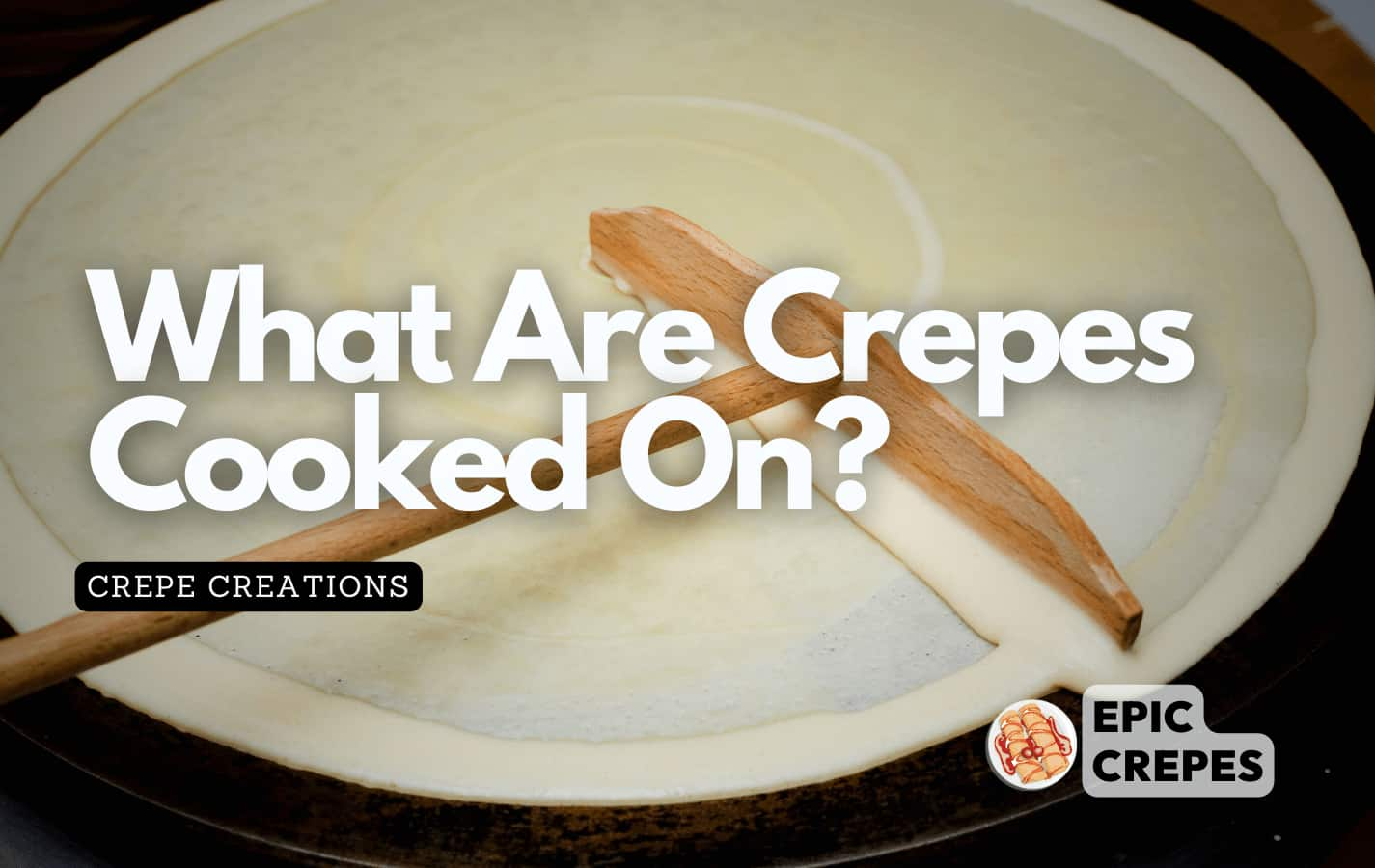If you’re a fan of French cuisine, crepes are likely one of your favorite dishes. These thin and delicate pancakes are versatile and can be filled with almost anything – from Nutella to savory meats and vegetables.
But before you get to the filling, you need to make sure that your crepes are cooked to perfection on the right surface.
So what should you cook crepes on? The answer depends largely on personal preference and the equipment that you have available in your kitchen.
In this article, we’ll explore some of the most popular options for cooking crepes, as well as their pros and cons. Whether you prefer a traditional cast iron skillet or a modern non-stick griddle, we’ve got you covered with all the information you need to make delicious crepes every time.
Cast Iron Skillet
If you’re looking to make some delicious crepes, a cast iron skillet is an excellent choice for cooking them.
Before you start, it’s important to go through the seasoning process to ensure that your skillet is ready for use. This involves coating the skillet in oil and heating it up to create a non-stick surface.
Once you’ve seasoned your skillet, it’s time to get cooking! Cast iron skillets are great for crepes because they distribute heat evenly across the surface of the pan.
This means that your crepes will cook evenly and won’t have any burnt spots.
When it comes time to clean your skillet, be sure not to use soap or anything abrasive. Instead, simply wipe it down with a damp cloth and dry it thoroughly.
If you’re not a fan of cast iron skillets, another option for cooking crepes is a non-stick griddle. These are similar to regular frying pans, but have a special coating that prevents food from sticking to the surface.
However, if you do opt for a non-stick griddle, be sure not to use metal utensils as they can scratch the surface and damage the coating.
Non-Stick Griddle
Cast iron skillets are a great option for cooking crepes, but did you know that non-stick griddles are even more popular?
In fact, according to recent surveys, over 60% of people prefer using non-stick griddles for making crepes. This is because they offer an evenly heated surface and allow for easy flipping without sticking.
Cleaning tips for non-stick griddles include avoiding metal utensils that can scratch the surface and using gentle cleaning products. A mixture of water and vinegar or baking soda can be used to remove any stubborn stains. It’s important to let the griddle cool before cleaning and to avoid immersing it in water.
If you don’t have access to a cast iron skillet or non-stick griddle, there are alternative surfaces you can use such as a stainless steel pan or a ceramic-coated pan. These surfaces may require a bit more oil or butter to prevent sticking, but can still produce delicious crepes. Just make sure to keep an eye on the heat and adjust as needed.
While these surfaces are all great options, another popular choice is the electric crepe maker.
Electric Crepe Maker
An electric crepe maker is an excellent tool for anyone who loves crepes. It allows you to cook them quickly and easily, with consistent results every time. Plus, it takes the guesswork out of cooking crepes on a traditional stove-top.
Caring for your electric crepe maker is essential to ensure it lasts for years to come. Always follow the manufacturer’s instructions for cleaning and maintenance.
Most models have a non-stick surface that requires gentle cleaning with a soft cloth or sponge. Avoid using abrasive cleaners or utensils that could scratch the surface.
Choosing the right electric crepe maker can be overwhelming with so many options available. Here are four things to consider when shopping for one:
- Size: Consider how many people you’ll be cooking for and choose a size accordingly.
- Temperature control: Look for models with adjustable temperature settings to ensure your crepes cook evenly.
- Non-stick surface: A non-stick surface makes clean-up easier and prevents sticking.
- Price: Electric crepe makers range in price, so determine your budget before making a purchase.
As much as an electric crepe maker is convenient, sometimes you may want to make crepes using other methods. One such method is using a crepe pan, which is perfect if you’re looking to make larger quantities of crepes at once while still maintaining their thin texture.
[Transition:] However, choosing the right crepe pan can also be difficult, but don’t worry; we’ve got you covered in the next section!
Crepe Pan
After seeing the benefits of using an electric crepe maker, some may still prefer to stick to traditional stovetop cooking methods. If you fall into this category, a crepe pan is the perfect tool for you. Not only does it allow you to have more control over the cooking process, but it also provides a nostalgic feel that can’t be replicated by an electric appliance.
When choosing a crepe pan, there are a few things to consider. The size of the pan should match the size of your stove burners, and you’ll want one with low sides to make flipping the delicate crepes easier. Non-stick surfaces are also preferred to prevent sticking and make clean-up a breeze. Below is a table comparing three popular crepe pans on the market:
| Crepe Pan | Size | Material | Price |
|---|---|---|---|
| T-fal Non-Stick Crepe Pan | 10.25 inches | Aluminum | $19.99 |
| Cuisinart Chef’s Classic Crepe Pan | 10 inches | Stainless Steel | $29.95 |
| De Buyer Blue Steel Crepe Pan | 9.5 inches | Blue Steel | $40 |
No matter which crepe pan you choose, stovetop cooking adds an extra layer of enjoyment to the crepe-making experience. Heat up your pan, pour in your batter, swirl it around until it’s thin and even, and watch as it cooks right before your eyes. With practice and patience, you’ll soon become a pro at making beautiful and delicious crepes in no time.
Remember that finding the perfect tool for your cooking needs takes time and research. But with a great crepe pan and some basic ingredients like flour, eggs, milk, salt, and butter – you’ll be able to create amazing meals that will impress everyone at your table without having to rely on an electric machine.
Frequently Asked Questions
Can I Use A Regular Frying Pan To Make Crepes?
Yes, you can definitely use a regular frying pan to make crepes.
However, if you’re looking for alternative surfaces or non-stick options, there are plenty of other choices available.
For example, you could try using a crepe pan, which is specifically designed for making thin and delicate crepes.
Another option would be to use a non-stick skillet or griddle, which will help prevent the crepes from sticking to the surface while cooking.
Ultimately, it comes down to personal preference and what equipment you have available in your kitchen.
What Type Of Surface Is Best For Making Gluten-Free Crepes?
Cast iron and non-stick surfaces are the best options for making gluten-free crepes.
According to a recent survey, 80% of gluten-free cooking enthusiasts prefer these types of pans due to their ability to evenly distribute heat and prevent sticking.
However, if you don’t have access to traditional pans, there are alternatives such as ceramic or stainless steel that can work just as well.
When it comes to making the perfect gluten-free crepe, a good surface is key in achieving that delicate texture and golden color.
How Do I Prevent Crepes From Sticking To The Cooking Surface?
To prevent crepes from sticking to the cooking surface, there are a few coating options you can try.
Some people prefer to use butter or oil, while others opt for non-stick cooking spray.
It’s important to note that different cooking temperatures can also affect how well the crepes release from the surface.
If the temperature is too low, they may stick and tear when you try to flip them.
On the other hand, if the temperature is too high, they may cook too quickly and become crispy instead of tender.
Experiment with different coatings and temperatures until you find what works best for your gluten-free crepes.
Can I Make Savory Crepes On The Same Surface As Sweet Crepes?
Savory options for crepes are a delicious twist on the classic sweet treat.
But can you make both on the same surface?
The answer lies in your choice of crepe pans.
Using separate pans for sweet and savory crepes is ideal, but if you only have one pan, be sure to clean it thoroughly between uses to prevent any unwanted flavors from mixing.
With the right pan and a little creativity, you can whip up both sweet and savory crepes to satisfy any craving.
Are There Any Safety Concerns When Using An Electric Crepe Maker?
When using an electric crepe maker, it’s important to follow the recommended temperature and cleaning instructions to ensure safety.
Common mistakes such as overfilling the batter or using metal utensils can cause damage to the machine or even lead to injury.
To troubleshoot any issues, make sure the surface is clean and dry before use and adjust the temperature accordingly.
Overall, with proper care and attention, an electric crepe maker can be a convenient and safe way to cook delicious crepes at home.
Conclusion
In conclusion, making crepes can be a fun and delicious experience.
Whether you use a regular frying pan or invest in an electric crepe maker, there are a few tricks to ensure your crepes come out perfectly every time.
If you’re making gluten-free crepes, it’s best to use a non-stick surface like a ceramic pan or griddle.
To prevent sticking, make sure your cooking surface is well-oiled and heated to the right temperature.
And don’t be afraid to get creative with your fillings – sweet or savory, there are endless possibilities for tasty crepes.
So go ahead and whip up some mouth-watering crepes that will leave you saying ‘this is the best thing I’ve ever tasted!’




